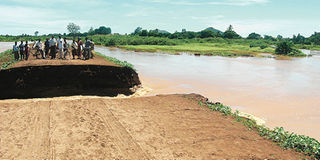UN report faults Kenya over flood control

Budalang’i residents view a damaged dyke along River Nzoia after past floods. A new United Nations report has faulted the Kenyan Government for failing to invest in flood control infrastructure November 28, 2012
A new United Nations report has faulted the Kenyan Government for failing to invest in flood control infrastructure.
Released on the sidelines of the ongoing climate change negotiations in Doha, Qatar, the report notes that dykes specifically in Budalang’i , western Kenya are poorly designed, resulting in underground seepage and backflows of water.
Constructed 24 years ago, the report conducted between May and August this year says, many of them are in urgent need of repair or replacement.
This perhaps explains why 72 percent of the 400 people interviewed in the low lying area, on the shores of Lake Victoria, are still experiencing the negative effects of the floods.
The survey was conducted by the UN Institute of Environment and Human Security as part of the Climate Development Knowledge Network Loss and Damage in vulnerable countries initiative.
Loss and Damage refers to negative effects of climate variability and climate change that people have not been able to cope with or adapt to.
The study also draws evidence from Loss and Damage in other four countries including Bangladesh, Bhutan, The Gambia and Micronesia.
Increase in severity
In Kenya, the survey warns that floods in the country are expected to increase in severity, with potentially devastating effects for people living near riverbanks.
An overwhelming number of respondents - 96 percent - say floods have become more frequent and intense over the past 20 years.
They have led to loss of lives, damage to infrastructure and disruption to the main sources of livelihood, such as crop production, fishing and livestock keeping.
"This has had severe implications for people’s food security, increased incidences of water borne diseases such as malaria, diarrhoea and typhoid,” it reads.
"Residents have been forced to come up with coping strategies including temporary relocation to camps where they receive relief material to sustain their families.
“Many respondents also said they had sold property, such as land and cattle, in order to cope with the effects of the flood,” reads the report.
The report states that 91 percent of the respondents indicate that they had received aid after the floods with many others resorting to low paying non agricultural work.
Sell assets
Another 20 percent said they resorted to selling some of their assets to buy food.
The report says failure to address loss and damage now will compromise development and ensure that vulnerable countries that have contributed least to global green house emissions will continue to suffer.
Koko Werner, one of the authors based at the United Nations University says: “We see that loss and damage is a reality today and these numbers are quite alarming. It is happening even though adaptation measures are taken.”
Speaking on behalf of the 48 countries in the Least Development Countries (LDC) group, chairman Dr Pa Ousman Jarju said: “This is a climate justice issue. Countries that contribute least to global green house emissions are the ones bearing the burden of loss and damage.”
“This is happening even though they have the most limited capacity to cope and adapt. This new report sheds light on the constraints we face in our fight against climate change.”
“Ignoring this knowledge can either mean our collective success or failure in stemming the pathways to loss and damage.”




